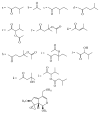Chemical Components and Cardiovascular Activities of Valeriana spp
- PMID: 26788113
- PMCID: PMC4695638
- DOI: 10.1155/2015/947619
Chemical Components and Cardiovascular Activities of Valeriana spp
Abstract
Valeriana spp. is a flowering plant that is well known for its essential oils, iridoid compounds such as monoterpenes and sesquiterpenes, flavonoids, alkaloids, amino acids, and lignanoids. Valeriana spp. exhibits a wide range of biological activities such as lowering blood pressure and heart rate, antimyocardial ischemia reperfusion injury, antiarrhythmia, and regulation of blood lipid levels. This review focuses on the chemical constituents and cardiovascular activities of Valeriana spp.
Figures





References
-
- Chen H.-B., Cheng J.-R. Taxonomic revision of the relative species of Valeriana officinalis Linn. from China. Bulletin of Botanical Research. 1991;3:29–40.
-
- Chen H. B., Cheng J. R. Studies on the medicinal plants of Valerianaceae in China. China Journal of Chinese Materia Medica. 1994;2(3):67–70. - PubMed
-
- Muller D., Pfeil T., von den Driesch V. Valeriana officinalis (monograph) Alternative Medicine Review. 2004;9(4):438–441. - PubMed
Publication types
LinkOut - more resources
Full Text Sources
Other Literature Sources
Miscellaneous

